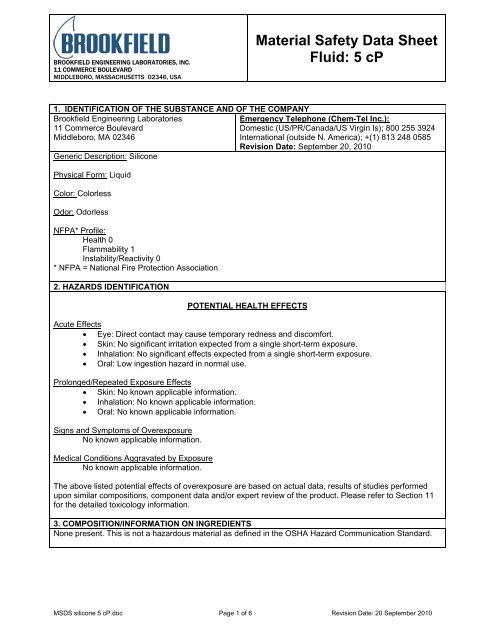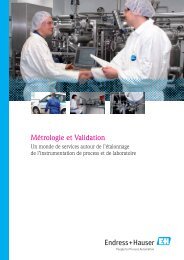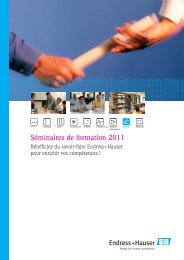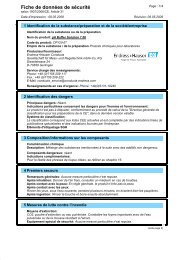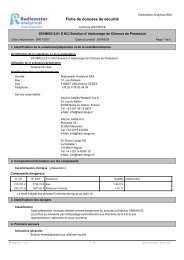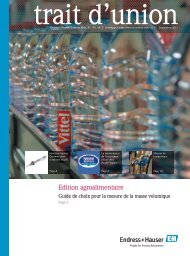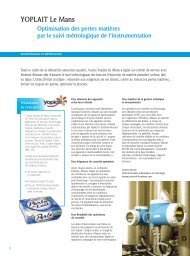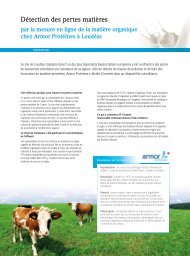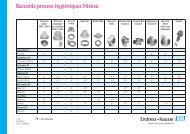Material Safety Data Sheet Fluid: 5 cP
Material Safety Data Sheet Fluid: 5 cP
Material Safety Data Sheet Fluid: 5 cP
Create successful ePaper yourself
Turn your PDF publications into a flip-book with our unique Google optimized e-Paper software.
BROOKFIELD ENGINEERING LABORATORIES, INC.<br />
11 COMMERCE BOULEVARD<br />
MIDDLEBORO, MASSACHUSETTS 02346, USA<br />
1. IDENTIFICATION OF THE SUBSTANCE AND OF THE COMPANY<br />
Brookfield Engineering Laboratories<br />
11 Commerce Boulevard<br />
Middleboro, MA 02346<br />
Generic Description: Silicone<br />
Physical Form: Liquid<br />
Color: Colorless<br />
Odor: Odorless<br />
NFPA* Profile:<br />
Health 0<br />
Flammability 1<br />
Instability/Reactivity 0<br />
* NFPA = National Fire Protection Association<br />
2. HAZARDS IDENTIFICATION<br />
<strong>Material</strong> <strong>Safety</strong> <strong>Data</strong> <strong>Sheet</strong><br />
<strong>Fluid</strong>: 5 <strong>cP</strong><br />
Emergency Telephone (Chem-Tel Inc.):<br />
Domestic (US/PR/Canada/US Virgin Is); 800 255 3924<br />
International (outside N. America); +(1) 813 248 0585<br />
Revision Date: September 20, 2010<br />
POTENTIAL HEALTH EFFECTS<br />
Acute Effects<br />
• Eye: Direct contact may cause temporary redness and discomfort.<br />
• Skin: No significant irritation expected from a single short-term exposure.<br />
• Inhalation: No significant effects expected from a single short-term exposure.<br />
• Oral: Low ingestion hazard in normal use.<br />
Prolonged/Repeated Exposure Effects<br />
• Skin: No known applicable information.<br />
• Inhalation: No known applicable information.<br />
• Oral: No known applicable information.<br />
Signs and Symptoms of Overexposure<br />
No known applicable information.<br />
Medical Conditions Aggravated by Exposure<br />
No known applicable information.<br />
The above listed potential effects of overexposure are based on actual data, results of studies performed<br />
upon similar compositions, component data and/or expert review of the product. Please refer to Section 11<br />
for the detailed toxicology information.<br />
3. COMPOSITION/INFORMATION ON INGREDIENTS<br />
None present. This is not a hazardous material as defined in the OSHA Hazard Communication Standard.<br />
MSDS silicone 5 <strong>cP</strong>.doc Page 1 of 6 Revision Date: 20 September 2010
BROOKFIELD ENGINEERING LABORATORIES, INC.<br />
11 COMMERCE BOULEVARD<br />
MIDDLEBORO, MASSACHUSETTS 02346, USA<br />
4. FIRST AID MEASURES<br />
Eye: Immediately flush with water.<br />
Skin: No first aid should be needed.<br />
Inhalation: No first aid should be needed.<br />
Oral: No first aid should be needed.<br />
Notes to Physician: Treat symptomatically.<br />
5. FIRE FIGHTING MEASURES<br />
Flash Point Range: >214 °F / >101.1 °C (Closed Cup)<br />
Autoignition Temperature: >752 °F / >400 °C<br />
Flammability Limits in Air: Not determined.<br />
<strong>Material</strong> <strong>Safety</strong> <strong>Data</strong> <strong>Sheet</strong><br />
<strong>Fluid</strong>: 5 <strong>cP</strong><br />
Extinguishing Media: On large fires use dry chemical, foam or water spray. On small fires use carbon<br />
dioxide (CO2), dry chemical or water spray. Water can be used to cool fire exposed containers.<br />
Fire Fighting Measures: Self-contained breathing apparatus and protective clothing should be worn in<br />
fighting large fires involving chemicals. Determine the need to evacuate or isolate the area according to your<br />
local emergency plan. Use water spray to keep fire exposed containers cool.<br />
Unusual Fire Hazards: None.<br />
6. ACCIDENTAL RELEASE MEASURES<br />
Containment/Clean up:<br />
Determine whether to evacuate or isolate the area according to your local emergency plan. Observe all<br />
personal protection equipment recommendations described in Sections 5 and 8. For large spills, provide<br />
diking or other appropriate containment to keep material from spreading. If diked material can be pumped,<br />
store recovered material in appropriate container. Clean up remaining materials from spill with suitable<br />
absorbant. Clean area as appropriate since spilled materials, even in small quantities, may present a slip<br />
hazard. Final cleaning may require use of steam, solvents or detergents. Dispose of saturated absorbant or<br />
cleaning materials appropriately, since spontaneous heating may occur. Local, state and federal laws and<br />
regulations may apply to releases and disposal of this material, as well as those materials and items<br />
employed in the cleanup of releases. You will need to determine which federal, state and local laws and<br />
regulations are applicable. Sections 13 and 15 of this MSDS provide information regarding certain federal<br />
and state requirements.<br />
Note: See section 8 for Personal Protective Equipment for Spills.<br />
7. HANDLING AND STORAGE<br />
Use with adequate ventilation. Avoid eye contact.<br />
Use reasonable care and store away from oxidizing materials.<br />
MSDS silicone 5 <strong>cP</strong>.doc Page 2 of 6 Revision Date: 20 September 2010
BROOKFIELD ENGINEERING LABORATORIES, INC.<br />
11 COMMERCE BOULEVARD<br />
MIDDLEBORO, MASSACHUSETTS 02346, USA<br />
8. EXPOSURE CONTROLS / PERSONAL PROTECTION<br />
Component Exposure Limits:<br />
There are no components with workplace exposure limits.<br />
Engineering Controls:<br />
• Local Ventilation: None should be needed.<br />
• General Ventilation: Recommended.<br />
<strong>Material</strong> <strong>Safety</strong> <strong>Data</strong> <strong>Sheet</strong><br />
<strong>Fluid</strong>: 5 <strong>cP</strong><br />
Personal Protective Equipment for Routine Handling:<br />
• Eyes: Use proper protection - safety glasses as a minimum.<br />
• Skin: Washing at mealtime and end of shift is adequate.<br />
• Suitable Gloves: Handle in accordance with good industrial hygiene and safety practices.<br />
• Inhalation: No respiratory protection should be needed.<br />
• Suitable Respirator: None should be needed.<br />
Personal Protective Equipment for Spills:<br />
• Eyes: Use proper protection - safety glasses as a minimum.<br />
• Skin: Washing at mealtime and end of shift is adequate.<br />
• Inhalation/Suitable Respirator: No respiratory protection should be needed.<br />
• Precautionary Measures: Avoid eye contact. Use reasonable care.<br />
Comments:<br />
When heated to temperatures above 150 degrees C in the presence of air, product can form formaldehyde<br />
vapors. Formaldehyde is a potential cancer hazard, a known skin and respiratory sensitizer, and an irritant<br />
to the eyes, nose, throat, skin, and digestive system. Safe handling conditions may be maintained by<br />
keeping vapor concentrations within the OSHA Permissible Exposure Limit for formaldehyde.<br />
Note: These precautions are for room temperature handling. Use at elevated temperature or aerosol/spray<br />
applications may require added precautions. For further information regarding aerosol inhalation toxicity,<br />
please refer to the guidance document regarding the use of silicone-based materials in aerosol applications<br />
that has been developed by the silicone industry (www. SEHSC.com).<br />
MSDS silicone 5 <strong>cP</strong>.doc Page 3 of 6 Revision Date: 20 September 2010
BROOKFIELD ENGINEERING LABORATORIES, INC.<br />
11 COMMERCE BOULEVARD<br />
MIDDLEBORO, MASSACHUSETTS 02346, USA<br />
9. PHYSICAL AND CHEMICAL PROPERTIES<br />
Physical Form: Liquid<br />
Color: Colorless<br />
Odor: Odorless<br />
Specific Gravity Range @ 25°C: .915<br />
Viscosity: 5 <strong>cP</strong><br />
Freezing/Melting Point: Not determined.<br />
Boiling Point: > 35 °C<br />
Vapor Pressure @ 25°C: Not determined.<br />
Vapor Density: Not determined.<br />
Solubility in Water: Not determined.<br />
pH: Not determined.<br />
Volatile Content: Not determined.<br />
Flashpoint: >214 °F / >101.1 °C (Closed Cup)<br />
Autoignition Temperature: >752 °F / >400 °C<br />
Flammability Limits in Air: Not determined.<br />
<strong>Material</strong> <strong>Safety</strong> <strong>Data</strong> <strong>Sheet</strong><br />
<strong>Fluid</strong>: 5 <strong>cP</strong><br />
Note: The above information is not intended for use in preparing product specifications.<br />
10. STABILITY AND REACTIVITY<br />
Chemical Stability: Stable.<br />
Hazardous Polymerization: Hazardous polymerization will not occur.<br />
Conditions to Avoid: None.<br />
<strong>Material</strong>s to Avoid: Oxidizing material can cause a reaction.<br />
Hazardous Decomposition Products<br />
Thermal breakdown of this product during fire or very high heat conditions may evolve the following<br />
decomposition products: Carbon oxides and traces of incompletely burned carbon compounds. Silicon<br />
dioxide. Formaldehyde.<br />
11. TOXICOLOGICAL INFORMATION<br />
Special Hazard Information on Components:<br />
No known applicable information.<br />
MSDS silicone 5 <strong>cP</strong>.doc Page 4 of 6 Revision Date: 20 September 2010
BROOKFIELD ENGINEERING LABORATORIES, INC.<br />
11 COMMERCE BOULEVARD<br />
MIDDLEBORO, MASSACHUSETTS 02346, USA<br />
<strong>Material</strong> <strong>Safety</strong> <strong>Data</strong> <strong>Sheet</strong><br />
<strong>Fluid</strong>: 5 <strong>cP</strong><br />
12. ECOLOGICAL INFORMATION<br />
Environmental Fate and Distribution:<br />
• Air: This product is a high molecular weight liquid polymer which has a very low vapor pressure (80% during the sewage<br />
treatment process.<br />
Environmental Effects:<br />
• Toxicity to Water Organisms: Based on analogy to similar materials this product is expected to<br />
exhibit low toxicity to aquatic organisms.<br />
• Toxicity to Soil Organisms: Experiments show that when sewage sludge containing<br />
polydimethylsiloxane is added to soil, it has no effect on soil micro-organisms, earthworms or<br />
subsequent crops grown in the soil.<br />
• Bioaccumulation: This product is a liquid and is a high molecular weight polymer. Due to its physical<br />
size it is unable to pass through, or be absorbed by biological membranes. This has been confirmed<br />
by testing or analogy with similar products.<br />
Fate and Effects in Waste Water Treatment Plants:<br />
This product or similar products has been shown to be non-toxic to sewage sludge bacteria.<br />
Ecotoxicity Classification Criteria<br />
Hazard Parameters (LC50 or EC50) High Medium Low<br />
Acute Aquatic Toxicity (mg/L) 1 and 100<br />
Acute Terrestrial Toxicity 100 and 2000<br />
This table is adapted from "Environmental Toxicology and Risk Assessment", ASTM STP 1179, p.34, 1993.<br />
This table can be used to classify the ecotoxicity of this product when ecotoxicity data is listed above.<br />
Please read the other information presented in the section concerning the overall ecological safety of this<br />
material.<br />
13. DISPOSAL CONSIDERATIONS<br />
RCRA Hazard Class (40 CFR 261):<br />
When a decision is made to discard this material, as received, is it classified as a hazardous waste? No<br />
State or local laws may impose additional regulatory requirements regarding disposal.<br />
MSDS silicone 5 <strong>cP</strong>.doc Page 5 of 6 Revision Date: 20 September 2010
BROOKFIELD ENGINEERING LABORATORIES, INC.<br />
11 COMMERCE BOULEVARD<br />
MIDDLEBORO, MASSACHUSETTS 02346, USA<br />
14. TRANSPORT INFORMATION<br />
DOT Road Shipment Information (49 CFR 172.101): Not subject to DOT.<br />
Ocean Shipment (IMDG): Not subject to IMDG code.<br />
<strong>Material</strong> <strong>Safety</strong> <strong>Data</strong> <strong>Sheet</strong><br />
<strong>Fluid</strong>: 5 <strong>cP</strong><br />
Air Shipment (IATA): Not subject to IATA regulations.<br />
15. REGULATORY INFORMATION<br />
Contents of this MSDS comply with the OSHA Hazard Communication Standard 29 CFR 1910.1200.<br />
TSCA Status: All chemical substances in this material are included on or exempted from listing on the TSCA<br />
Inventory of Chemical Substances.<br />
EPA SARA Title III Chemical Listings:<br />
• Section 302 Extremely Hazardous Substances (40 CFR 355): None.<br />
• Section 304 CERCLA Hazardous Substances (40 CFR 302): None.<br />
• Section 311/312 Hazard Class (40 CFR 370):<br />
Acute: No<br />
Chronic: No<br />
Fire: No<br />
Pressure: No<br />
Reactive: No<br />
Section 313 Toxic Chemicals (40 CFR 372): None present or none present in regulated quantities.<br />
Note: Chemicals are listed under the 313 Toxic Chemicals section only if they meet or exceed a reporting threshold.<br />
Supplemental State Compliance Information:<br />
• California<br />
Warning: This product contains the following chemical(s) listed by the State of California under the<br />
Safe Drinking Water and Toxic Enforcement Act of 1986 (Proposition 65) as being known to cause<br />
cancer, birth defects or other reproductive harm.<br />
None known.<br />
• Massachusetts<br />
No ingredient regulated by MA Right-to-Know Law present.<br />
• New Jersey<br />
CAS Number Wt % Component Name<br />
63148-62-9 > 60.0 Polydimethylsiloxane<br />
• Pennsylvania<br />
CAS Number Wt % Component Name<br />
63148-62-9 > 60.0 Polydimethylsiloxane<br />
16. OTHER INFORMATION<br />
These data are offered in good faith as typical values and not as product specifications. No warranty, either<br />
expressed or implied, is hereby made. The recommended industrial hygiene and safe handling procedures<br />
are believed to be generally applicable. However, each user should review these recommendations in the<br />
specific context of the intended use and determine whether they are appropriate.<br />
MSDS silicone 5 <strong>cP</strong>.doc Page 6 of 6 Revision Date: 20 September 2010


